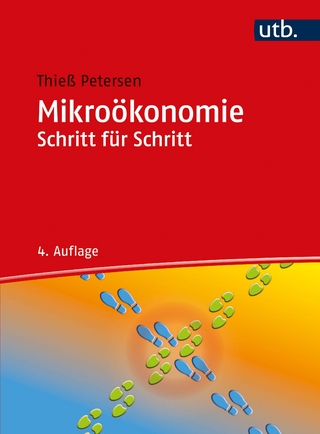
Teaching Principles of Microeconomics
Edward Elgar Publishing Ltd (Verlag)
978-1-0353-2370-8 (ISBN)
Beyond offering guidance to educators on how to improve students’ learning experience, the book proposes measures for addressing many of the vexing challenges that face the economics discipline today. Chapters provide suggestions on (1) how to capture students’ attention and ensure their continued engagement, (2) including course content that focuses on important public policy topics and pressing issues within modern society, (3) adopting evidence-based pedagogical strategies in the classroom and online, and (4) tackling issues of diversity, equity, and inclusion within the discipline. The ideas advanced in this illuminating guide highlight the possibility of continued improvement throughout one’s teaching career.
The jargon-free advice in this insightful teaching guide will also be of interest to deans, teaching and learning center directors, and other administrators of undergraduate institutions.
Edited by Mark Maier, Professor of Economics, Glendale Community College and Phil Ruder, Professor of Economics, Pacific University, US
Contents:
1 Improving the Principles of Microeconomics course 1
Phil Ruder and Mark Maier
PART I TRADITIONAL AND ALTERNATIVE APPROACHES
2 The deep work of teaching essential Microeconomic Principles 8
Gail M. Hoyt
3 Considerations for the textbook selection process in
Principles of Microeconomics 25
Erin A. Yetter
4 Asynchronicity, access, and content: teaching economics
in a shifting landscape 44
Belinda Archibong, Olivia Bobrownicki, Rajiv Sethi, and
Homa Zarghamee
5 The issues approach to teaching Principles of Microeconomics 59
Wendy A. Stock
6 Revising the traditional Microeconomics course: engaging
students via problem-based, positive, paradigmatic pluralism 74
Geoffrey E. Schneider
PART II UPDATING COURSE CONTENT
7 Where is the “behavioral” in Introductory Microeconomics? 88
Simon D. Halliday and Emily C. Marshall
8 Suggestions for incorporating sustainability into Principles
of Microeconomics 108
Jack Reardon
PART III INCLUSIVE TEACHING
9 Promoting inclusivity in Principles of Microeconomics 124
Jennifer Imazeki
10 Creating an anti-racist pedagogy in Principles of Microeconomics 136
Mary J. Lopez and Fernando Lozano
11 Feminist approaches in the Introductory Microeconomics course 152
Pratistha Joshi Rajkarnikar
12 Promoting gender diversity in Introductory Microeconomics 166
Martha Olney
PART IV PEDAGOGY
13 Writing in the Introductory Microeconomics course 180
Nathan D. Grawe and George Cusack
14 Taking advantage of structured peer interaction:
cooperative learning in the Principles of Microeconomics course 202
Scott P. Simkins, Mark Maier, and Phil Ruder
15 Teaching with experiments in the Introductory
Microeconomics course 217
Tisha L.N. Emerson
16 Teaching the Introductory Microeconomics course with
social media 230
Abdullah Al-Bahrani, Darshak Patel, and Brandon Sheridan
17 Teaching Introductory Microeconomics online 243
Steven Greenlaw
18 Using Excel to teach Principles of Microeconomics 257
Humberto Barreto
Index
| Erscheinungsdatum | 03.08.2023 |
|---|---|
| Reihe/Serie | Elgar Guides to Teaching |
| Verlagsort | Cheltenham |
| Sprache | englisch |
| Maße | 156 x 234 mm |
| Themenwelt | Sozialwissenschaften ► Pädagogik |
| Wirtschaft ► Volkswirtschaftslehre ► Mikroökonomie | |
| ISBN-10 | 1-0353-2370-2 / 1035323702 |
| ISBN-13 | 978-1-0353-2370-8 / 9781035323708 |
| Zustand | Neuware |
| Haben Sie eine Frage zum Produkt? |
aus dem Bereich


